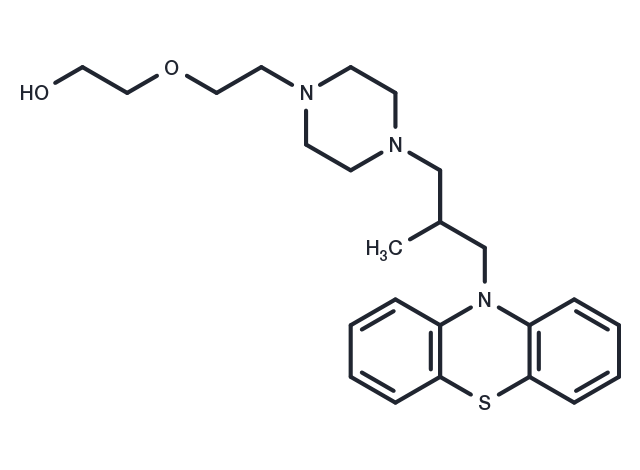store at low temperature
Powder: -20°C for 3 years | In solvent: -80°C for 1 year

Dixyrazine (UCB 3412)has a transient antihypertensive effect, prevents cerebral edema induced by injections of ichthyosperm sulfate, and may be used in the study of neurologically related disorders.

| Pack Size | Availability | Price/USD | Quantity |
|---|---|---|---|
| 1 mg | 5 days | $ 197.00 | |
| 2 mg | 5 days | $ 269.00 | |
| 5 mg | 6-8 weeks | $ 413.00 | |
| 10 mg | 6-8 weeks | $ 662.00 | |
| 25 mg | 5 days | $ 1,090.00 | |
| 1 mL * 10 mM (in DMSO) | 6-8 weeks | $ 388.00 |

| Description | Dixyrazine (UCB 3412)has a transient antihypertensive effect, prevents cerebral edema induced by injections of ichthyosperm sulfate, and may be used in the study of neurologically related disorders. |
| In vivo | Pretreatment with Dixyrazine (10 mg/kg) completely prevents brain edema and significantly reduces the increase of albumin in cerebrospinal fluid (CSF)[2]. In conscious rats subjected to acute hypertension provoked by i.v. adrenaline or bicuculline, the phenothiazine Dixyrazine (5 mg/kg i.v.) has minimal, transient hypotensive effects but significantly reduces the leakage of 126I labeled serum albumin. The diameters of pial arteries and veins are continuously measured with a multichannel videoangiometer through a closed cranial window in anesthetized rats before and after i.v. injection of Dixyrazine (5 mg/kg). Dixyrazine, at a dose of 5 mg/kg, induces a slight transitory decrease in blood pressure (10-20 mm Hg). The maximum mean arterial pressure (MAP) is slightly but not significantly lower in Dixyrazine-treated rats[1]. |
| Synonyms | UCB 3412 |
| Molecular Weight | 427.6 |
| Formula | C24H33N3O2S |
| CAS No. | 2470-73-7 |
store at low temperature
Powder: -20°C for 3 years | In solvent: -80°C for 1 year
DMSO: 80 mg/mL (187.09 mM), Sonication is recommended.
You can also refer to dose conversion for different animals. More
bottom
Please see Inhibitor Handling Instructions for more frequently ask questions. Topics include: how to prepare stock solutions, how to store products, and cautions on cell-based assays & animal experiments, etc.
Dixyrazine 2470-73-7 Others UCB 3412 inhibitor inhibit
